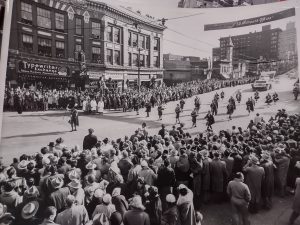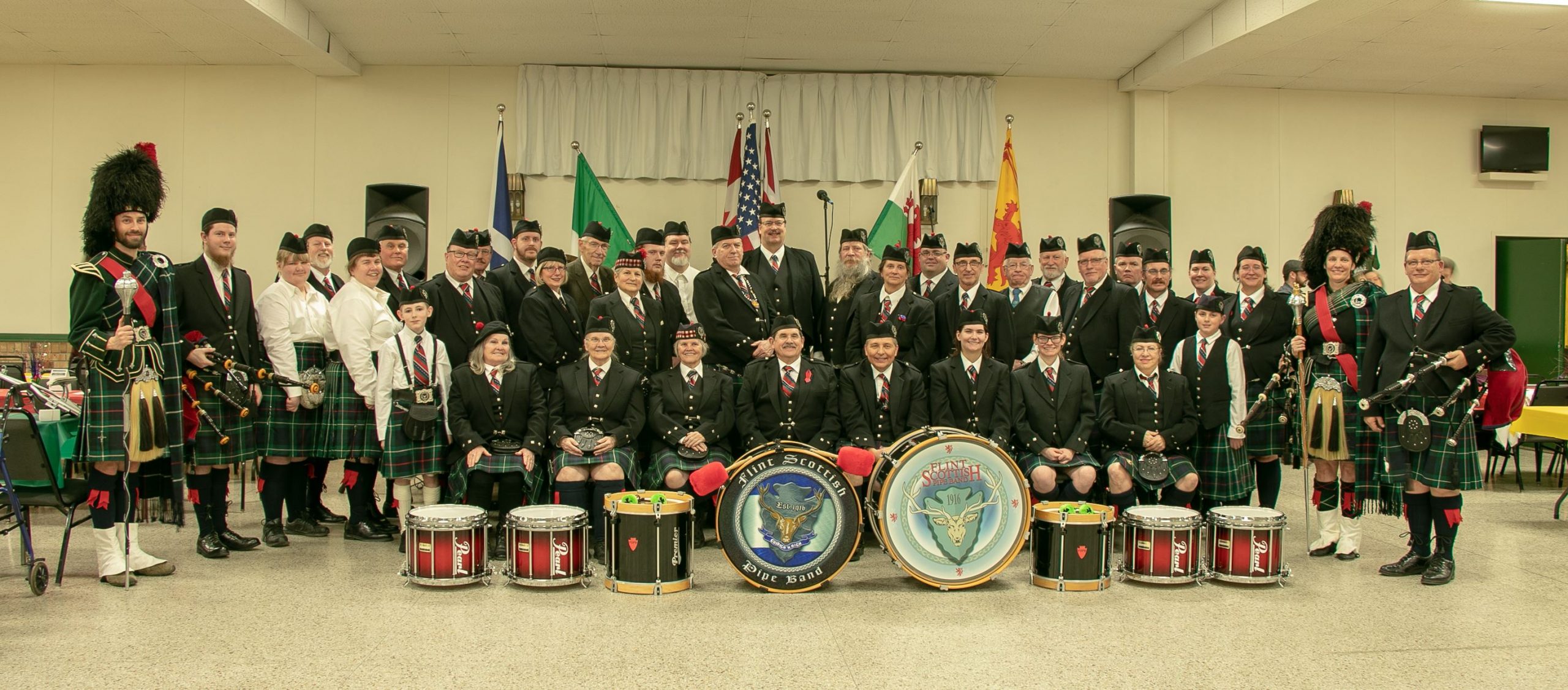
By 1916, Flint was in the middle of an automobile manufacturing frenzy. Buick was already in operation and AC Spark Plug was off and running. Streets were crowded with Monroe, Paterson and Dalton cars. General Motors, started in 1908, was just beginning to rev the engine. All of this hustle and bustle was attracting thousands of immigrants to the city with hope of forging a better life. Irish, Jewish, Polish, Spanish, Italians, Ukrainians and others brought their families to Flint. Another group, the Scots, joined them.
The Flint Scottish Pipe Band was founded in 1916 when the Clan MacKenzie, a society that helped settle Scottish immigrants, sponsored the band. During that time, Flint saw an influx of Scottish immigrants who took jobs in factories.
The Flint Scottish gave new immigrants a way to make friends, connect with their homeland, and become involved in the local community. The Clan MacKenzie also served as a safety net; members paid into a fund that supported families when they were injured or sick.
Emigration from Scotland peaked in the nineteenth century, when more than a million Scots left for the United States, taking advantage of the regular Atlantic steam-age shipping industry which was itself largely a Scottish creation, contributing to a revolution in transatlantic communication.
Scottish emigration to the United States followed, to a lesser extent, during the twentieth century, when Scottish heavy industry declined. This new wave peaked in the first decade of the twentieth century. Many qualified workers emigrated overseas, a part of which, established in Canada, later went on to the United States.
During the early 20th century, manufacturing industries became the main source of revenue for Michigan – in large part, because of the automobile. In 1897, the Olds Motor Vehicle Company opened a factory in Lansing. In 1903, Ford Motor Company was also founded nearby in Detroit. With the mass production of the Ford Model T, Detroit became the world capital of the auto industry. A restless innovator, Ford devised the modern assembly line. In 1908, the fledgling company introduced the Model T, a car whose standardized production would revolutionize the industry. Six years later, with hopes of building a stable, loyal workforce, Ford announced the five-dollar day, leading to a dramatic increase in pay for industrial workers. Word of Ford’s high wages—along with Ford’s international recruiting efforts—turned the Motor City into one of the most racially and ethnically diverse places in America. The auto magnate recruited skilled artisans from the shipyards of Scotland and England and blue-collar workers from the rural Midwest, as well as workers from Mexico and Lebanon, and African Americans from the city’s rapidly growing population of southern migrants.
In 1904 William Durant of the Flint, Michigan Durant Coach Works, a maker of horse carriages, set his sights on Buick Motor Cars which he soon acquired. General Motors was formed a few years later as William Durant along with Alfred Sloan purchased Oldsmobile, Cadillac, Oakland and other car companies. They soon moved their headquarters from Flint, Michigan to Detroit, Michigan. General Motors is based in Detroit, Chrysler is located in Auburn Hills, and Ford is headquartered in nearby Dearborn. Both corporations constructed large industrial complexes in the Detroit metropolitan area, exemplified by the River Rouge Plant, which have made Michigan a national leader in manufacturing since the 1910s. This industrial base produced greatly during World War I, filling a huge demand for military vehicles.
Thanks to new federal laws, labor unions grew rapidly after 1935, and for the first time became a major presence in large factories. The Flint Sit-Down Strike of 1936–1937 was the decisive event in the formation of the United Auto Workers Union (UAW). Strikers occupied several General Motors plants for more than forty days, and repelled (in nonviolent fashion) the efforts of the state courts, local police and National Guard to remove them. GM signed a contract that legitimized the UAW, and its membership in the next year grew from 30,000 to 500,000 members.
At approximately 10 a.m. on November 23rd in 1954, Chevrolet General Manager Thomas Keating drove a gold plated 1955 Chevrolet Bel Air Sport Coupe off a Flint, Michigan assembly line, marking the 50 millionth automobile produced by General Motors. Shortly thereafter it would be loaded onto a flatbed parade float and towed through downtown Flint, preceded by the Flint Scottish Pipe Band! Thousands of people packed the streets to get a glimpse of the historic vehicle. A number of other important automobiles and people flowed through the streets that day, including the first Cadillac produced under GM ownership.
Works Cited
“Flint Scottish Pipe Band the Heritage of the Highlands.” My City Magazine, 3 Feb. 2020, www.mycitymag.com/flint-scottish-pipe-band-the-heritage-of-the-highlands/. Accessed 3 Apr. 2023.
History, Automotive. “November 23, 1954 – the 50 Millionth General Motors Car Is Produced.” This Day in Automotive History, 23 Nov. 2021, automotivehistory.org/50-millionth-gm/. Accessed 3 Apr. 2023.
Staff, StateSide. “In 1916, Flint Scottish Pipe Band Brought New Immigrants Together. Today, Friends Keep It Alive.” Michigan Radio, 22 Feb. 2017, www.michiganradio.org/arts-culture/2017-02-22/in-1916-flint-scottish-pipe-band-brought-new-immigrants-together-today-friends-keep-it-alive. Accessed 3 Apr. 2023.
Sugrue, Thomas. “Motor City: The Story of Detroit | AP US History Study Guide from the Gilder Lehrman Institute of American History.” Www.gilderlehrman.org, 31 July 2012, ap.gilderlehrman.org/history-by-era/politics-reform/essays/motor-city-story-detroit.
Wikipedia Contributors. “History of Michigan.” Wikipedia, Wikimedia Foundation, 15 Apr. 2019, en.wikipedia.org/wiki/History_of_Michigan.


Leave a Reply